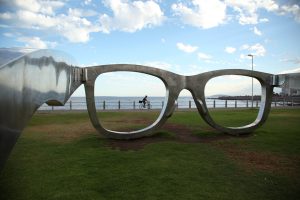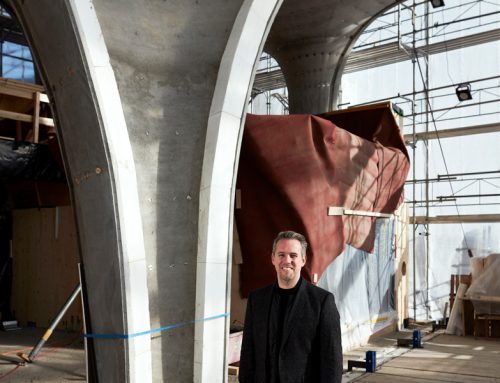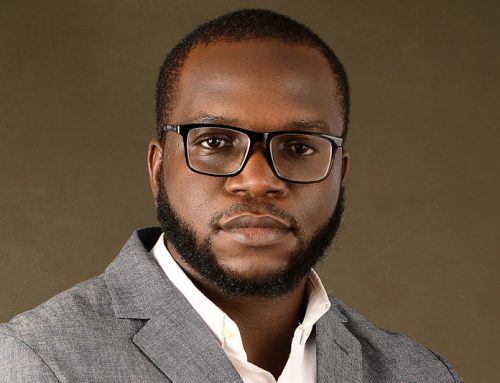
Michael Elions polycarbonate artwork of Sunglasses, dedicated to Nelson Mandela, at Sea Point, Cape Town. The piece controversially co-funded by Ray-Ban is considered to be in poor taste by some. Image Jayne Haywood. 21.03.15
– Rhythms of South Africa
Perceptions of South Africa wildly fluctuate from hope and excitement to fear and uncertainty. In August South Africa is holding its most hotly contested municipal elections since 1994. Is there more pessimism than optimism? We explore some of the perceptions and realities.
South Africa is like a complex piece of music that loops between the deep-rooted love of this land and fear of consuming chaos. Its rhythm menacingly charges towards the brink of no return; then surprises us with shining interludes of confidence and respite.
Warmed by the South African sun, we celebrate the escape from junk status and the resurrection of Finance Minister Pravin Gordhan. But then the chorus briskly changes, shifting back to peril and the threat of state capture, corruption, crime, unemployment, racist slurs and the pressing reality of the poverty of millions.
The average working citizen in South Africa is simply not making enough money to cover the basics – food, clothing, housing, education and transport. There are exceptions. Some are doing extremely well, and we have one of the biggest pay gaps in the world. A recent report by Mergence Investment Managers found that CEOs of JSE-listed companies earn, on average, 140 times more than the average worker. Among some of the top listed companies this increases to as much as 725 times their workers’ average salary.
This is not sustainable. If we look at our current unemployment rate, conservatively pegged at 25%, and we add this to the inflation rate and the population growth rate, the future is looking bleak for the majority of South Africans. The imbalance does not bode well for stability or greater equality, for which democratic South Africa stands.
The fact that inequality is a global problem is no consolation. Harvard professor Larry Summers points out: in 1965, the ratio of CEO compensation to the compensation of the average worker in the United States was 20:1. Today it’s 331:1.
So what’s the good news? The heart of South Africa’s good news is to be found in the host of socio-economic projects, many of them partnering with Wits, other South African universities and the private sector.
Here, you will find stores of goodwill and hope. Innovative efforts and research programmes are helping thousands of young people to graduate, develop skills and find suitable employment. New entrepreneurs are being assisted to develop businesses; vast water projects are working on cleaning up rivers and catchments; solar and wind projects are changing the energy landscape, corporates are investing in communities, education, sport, art, music, food security and conservation. So many more South Africans are experiencing opportunities that never existed before, and are running with them.
Wits has many extraordinary alumni from financially impoverished backgrounds who are graduating well against all the odds through courage, determination and intelligence. Wits graduates enter the working world with a heightened sense of social responsibility and a commitment to help educate the next generation.
There are a wealth of inspiring stories of ordinary people in this country: groups of mothers who daily rise at dawn in Joburg to catch taxis to the fresh produce market where they buy vegetables in bulk at wholesale prices. They divide up their purchases and sell them in the townships or on the pavements outside shopping malls to support their children and put them through school and university.
Then there is South Africa’s peerless Constitution and a legal system led by judges who have repeatedly demonstrated their independence and fairness, bringing to book everyone from corporate price colluders to the President. Which brings us full circle to the pervasive political and economic concerns and the need for all South Africans to commit to better understanding each other’s needs, lives and backgrounds.
As an elderly doctor once told me, we are so fortunate that there is still so much goodwill and dignity among so many people in South Africa; if it were not so, the country would have imploded long ago.
The Top 1%
Wits’ strategic goals over the next 10 years include raising its international profile in research and postgraduate training. The University is in the top 1% of world universities in nine of 22 fields, as listed by Essential Science Indicators. Wits research has a high reputation internationally and more than 80% of its publications are in international journals attracting considerable numbers of citations. To further boost our postgraduate capability, we have initiated a new funding stream called Honours to PhD in 5 Years. This funding is specifically aimed at growing the number of PhD graduates. Several donors are supporting this.
Homecoming Revolution
Don’t wait until South Africa gets better, come home and help it to get better. That’s the message of Homecoming Revolution, now 13 years old. Founder CEO Angel Jones says 359 000 South Africans have returned to the country from abroad in the past five years. She decided to come home in 2000 after hearing Nelson Mandela speak while she was living in London.
“During that speech Madiba told us that he loves us all so much and that he wanted to take us home with him. I was deeply moved and returned to South Africa 2000. I opened an advertising agency called Morris Jones and three years later we started Homecoming Revolution as a non-profit to encourage South Africans to return home from all over the world and to help build our new democracy.
Homecoming Revolution has since grown into a pan-African “mass repatriation vision” and recruitment business that places globally experienced Africans in positions in sub-Saharan Africa, with a focus on South Africa, Nigeria and Kenya.
Jones says that coming home was the best decision she could have made: “I am intensely patriotic and I would not choose to bring up my children anywhere else, despite the rollercoaster that is South Africa. Being here, you are part of the history unfolding, you are part of the living debate about what it means to be South African and African.”
She says that a few weeks back, during a speech she was giving, a student member of the Economic Freedom Fighters (EFF) heckled her for calling herself African. “So we debated this and the young woman, Khensani Masisi, and I have since come together and we are creating a forum where we will be introducing older white South Africans to young black South Africans so that they can get to know each other, debate these issues, assist each other.
“This is part of why South Africa is such an incredible place – unexpected consequences develop from chance encounters all the time. Earlier this year at the launch of Moeletsi Mbeki’s new book A Manifesto For Social Change – How to Save South Africa, he said that corporate white money and white South Africans should come together with the extreme Left in this country because they both have the most to lose. Imagine the possibility of these groups in the same room, looking each other in the eye and engaging in generative dialogue.”
Jones believes that economic and racial dialogue is crucial for South Africa because what frightens her most, beyond crime and corruption, is the racial divide: “People become increasingly polarised, particularly around elections, when they have not committed to getting to know each other and opening themselves to alternative opinions and perspectives.
“We also have to be cautious of reacting to the edited versions in the media of statements from high-profile politicians like Julius Malema. I was at a talk where he clarified that it is not white people but rather white supremacy that the EFF hates. White supremacy remains a feature of South Africa’s economic landscape and any kind of economic supremacy is of concern, not only in South Africa, but globally. The world’s 62 richest billionaires, many of whom were represented at Davos, have as much wealth as 3.6-billion people today.”
This is according to Oxfam’s pre-Davos report, which compared this to the 2010 figure, when 388 of the world’s richest owned as much as the 3.6-billion. The same report pointed out that the wealth of the world’s poorest 50% dropped by 41% between 2010 and 2015. In the same period, the wealth of the world’s richest increased by US$500-billion to $1.76-trillion.
These figures, by all measures of justice and a better quality of life for all, are definitely heading the wrong way. It is not fair that 1% of people in the world should own more wealth than the other 99% combined.
Jones’s point is that many of the issues that South Africa is facing are global issues, but this means we have to try even harder to achieve equality and freedom.
For more information: www.homecomingrevolution.com
Reasons for Hope
Excerpt from a column in Leadership Magazine by Professor Owen Skae, President of the South African Business Schools Association
I am surprised that more was not made of Reasons for Hope, a national opinion survey published in March this year by the South African Institute of Race Relations (IRR) that looked at public attitudes to race relations, jobs and other key issues in 2015.
Though acrimonious race debates have gripped the country of late, the IRR survey results reveal a different picture.
The introduction to the report says: Social media, in particular, have spoken of an ‘unbridgeable gap’ that has developed between black and white South Africans. South Africans were said to have ‘no interest in reconciliation, redress, and nation building’. The white community was alleged to be racked with racism and filled with a deep desire to bring back apartheid. Black South Africans were said to be filled with hatred for whites and a strong desire for vengeance. Threats of racial violence were made. The perception created was of a country on the verge of a race war.
Perceptions are powerful because they fuel public opinion, and, as the report puts it, if this process continues unchecked, it may not take long before real damage to race relations is done.
The report emphasises that it did not rely on perceptions or the subjective opinions of individual commentators. Instead, it reported on the results of a field survey, which asked South Africans how they themselves feel about race relations:
Our field survey canvassed the views of a balanced sample of 2 245 people from all nine provinces. It covered both rural and urban areas and all socio-economic strata. Of the respondents, 78.3% were black, 9% were coloured, 2.8% were Indian, and 9.9% were white. Approximately half the respondents were under the age of 34, and their educational profile mirrored that of the country. Of those surveyed a quarter were unemployed. Of those with jobs, 2.8% worked in the informal sector and 38.8% were employed in the formal sector.
The feedback from the report is this: Far from being hostile towards one another, most South Africans, black and white, occupy a pragmatic middle ground on race relations. White South Africans understand and support the need for redress. Black South Africans do not believe that their white compatriots should be treated as second-class citizens. The overwhelming majority of both groups believe that they need each other for progress to be made.
The overwhelming majority, when asked to name the two most serious problems in South Africa not yet resolved since 1994, answered: unemployment and crime. In total, 55.9% of South Africans saw unemployment as the most pressing problem, while 28.8% cited crime.
Racism (which included xenophobia and reverse apartheid) was cited by 4.7% of respondents.
When asked whether South African sports teams should be selected “only on merit and ability and not by racial quotas”, the responses showed that 77% of all South Africans support purely merit-based selections without reference to racial quotas. No fewer than 74.2% of black South
Africans endorsed this view.
When asked what they made of all the talk of racism that dominates so many media headlines, 62% said: “All this talk of racism and colonialism is an attempt by politicians to find excuses for their own failures.”
Asked whether they thought that better education and more jobs would make the differences between the races steadily disappear, 82.2% of the respondents agreed.
The report concludes: We hope that the actual opinions of South Africans will serve as a ‘still small voice of calm’ that helps to cut through the divisive rhetoric we have witnessed this year.
South Africa – The Good News
“Positive developments about South Africa just don’t get reported in the mainstream media and most people, including South Africans, are not well-informed about the country; they do not know the facts, some of which are positive and serve to balance our national narrative,” says Wits diplomate (HDPM 1975), Steuart Pennington, CEO of South Africa – The Good News, an online news portal www.sagoodnews.co.za. Since 2004, Pennington has given over 550 talks on South Africa’s progress and prospects.
“My mission is to present both the good and the bad, I believe if our citizens understand and celebrate the good, they will have much more resolve to confront and deal with the bad.
“Over the past 22 years much has changed. We remain the 30th largest economy in the world from a GDP point of view, and this year our Global Competitiveness ranking improved from 56th out of 140 countries to 49th. We were the only country to improve seven places. But having said this we have previously been ranked as high as 38th. There are 235 countries globally, but only 140 have sufficient information for data to be collected and compiled, and only 40 have a population of more than 10 million. South Africa, with a population of 55 million-plus is the 25th largest.
“I spend much of my time researching how we compare, from a competitiveness perspective, with both the developed and developing world. I believe this to be important because a myopic view of our circumstances, and our ‘news’, very often leads to negative distortion of our position in the world.
“Generally, visitors to this country have a much more positive perspective! Some examples: in 1994 we had 3.5 million visitors, in 2015 15.5 million visitors crossed our borders, 10 million of which we described as ‘long haul’. Cape Town had 3 million visitors in Jan and Feb alone. By comparison Australia welcomes some 6 million visitors per annum.
“The World Tourism Council ranks South Africa as the 3rd fastest growing tourism destination globally (amongst countries with more than 9 million tourists). According to the Economist, South Africa currently ranks 24th globally in terms of total visitors.(France 83 million, UK 29 million, Switzerland 8.5 million, India 6.6 million, Australia 6 million).
“Cape Town was named the top tourist destination in the world in the 2016 Traveler’s Choice Destinations awards. Cape Town has been voted the Favourite City Worldwide for 2016 by 17 000 Telegraph readers in the UK. South Africa is also home to the world’s largest individually timed cycle race (the Cape Argus Cycle Race), the world’s largest open water swim (the Midmar Mile) and the world’s largest ultra-marathon (the Comrades Marathon).
“The above serves as an example of ‘news’ that is not well known, as we fill our daily narrative with stories of crime, potholes, taxis, incompetent civil servants, delivery protests, corruption, Guptas, racism and anything else that ‘bleeds’.
“Of course there are negative developments that we need to be really concerned about. Top of the list in my view is education. The Joint Education Trust (JET) – an independent non-profit organisation that operates across the state education sector in South Africa – cites that around 80% of schools in South Africa are dysfunctional as places of learning, 15% are functional and 5% are truly world class.
“There is no doubt that the government has worked hard on improving access, electricity, water and sanitation at schools, but teacher competence has declined, many headmasters are incompetent, far too many schools still do not have sports fields or programmes. Which is why it sticks in one’s craw when Sports Minister Fikile Mbalula imposes quotas at a national level and sanctions against some major sporting federations when he does little to promote sport and equip schools at primary and secondary level to give our youth sporting opportunities.
“Tertiary education in South Africa tells a far better story: nine of South Africa’s 23 universities rank in the top 4% of the 20 000 registered universities worldwide, and 11 in the top 8%. None of our Universities rank below 10 000th whereas many American universities do. (Source: QS Survey).”
Here is Pennington’s summary of the good and not good in South Africa:
-
Government:
Considering the performance of the Executive, the Judiciary and Administration (37 government departments) we have a mixed bag. What we witness in parliament, the Nkandla debacle, the corruption, the cronyism, is one helluva bad story. Trust between the social partners is the major casualty and is at an all-time low. In the Global Competitiveness Report various measures of ‘State Capacity’ are ranked in the bottom 20% of the 140 countries included. Plainly put, top leadership is behaving badly. Fortunately, we have strong civil society organisations and determined investigative journalists (SA’s media freedom is ranked 39th / 175 countries, ahead of the UK (40th) and the USA (43rd)). Our robust opposition politicians – the Democratic Alliance (DA) and Economic Freedom Fighters (EFF) – play a key role in exposing and rooting out the bad.
-
Civil society:
Again, a mixed bag: our labour environment and labour legislation ranks 128th/140 countries in the Global Competitiveness Report. But, we are blessed with an active, positive citizenry comprising over 100 000 NGOs and civil society organisations. The work they do, and the services they provide, is our untold story. We are ranked in the top 10 ‘giving’ countries (HSRC report) as our private sector donated some R9 billion to social causes and ordinary citizens some R15 billion. In addition, many large corporates have active ‘Employer assisted’ volunteering schemes.
-
The private sector and our global competitiveness
This is a good story, as borne out by the Economist and the Global Competitiveness Report (GCR) 2015/2016, which compares 12 ‘pillars’ of competitiveness using 120 measures.
Here are some of the GCR and Economist’s findings:
- The JSE ranks 16th in terms of ‘largest market capitalisation’ and the 2ndbest regulated. (Economist 2015).
- South Africa is the only African country that is a member of the G20.
- SA ranks 1st in respect of Auditing and Reporting standards, 6th in respect of Banking, and 14th out of 140 countries in strength of investor protection, according to the Global Competitiveness Report 2015/16.
- Over 90% of Africa’s imports and exports are conducted by sea. The busiest port in Africa is the Port of Durban which welcomes about 4 500 vessels per year and in 2013/14 it handled about 44.8 million tonnes of cargo.
- South Africa is ranked 17th out of a total of 145 economies in the World Economic Forum’s Global Gender Gap Report 2015, ahead of many developed nations, including, the UK (18th), United States (28), Canada (30), Australia (36) and France (57).
- At the end of 2014, South Africa entered the world top 10 of countries harnessing renewable energy from the sun, with 15 solar plants contributing 503 MW to the country’s electricity grid. SA’s renewable energy programme is the fastest growing in the world. Private sector investment in renewable energy generation will reach R193bn following the recent announcement of another 13 preferred bidders for wind and solar photovoltaic (PV) projects.
- SA is ranked 23rd out of 81 countries in the Jones Lang LaSalle’s ‘World’s most Transparent Real Estate Markets’ placing it well ahead of China, Brazil, India and Russia.
- South Africa ranks 24th out of 192 countries in the Economist’s ‘Largest Gold Reserves’ Index.
For the full list and more information: www.sagoodnews.co.za
Stats SA Population Survey for 2016
Statistics South Africa’s survey for 2016 showed that the country’s population has grown by more than 15-million people since 1996 – from 40.6-million in 1996 to 55.7-million today.
The black population has increased by nearly 4-million over the same period – from 41 000 938, to 44 891 603 people (9.5%).
The coloured population has increased from 4 615 401 people to 4 869 526 (5.5%), while the Indian/Asian population has grown from 1 286 930 people in 2011 to 1 375 834 (6.9%).
The white population has declined from 4 586 838 in 2011 to 4 516 691 in 2016 – a decrease of 70,147 people (1.5%).




